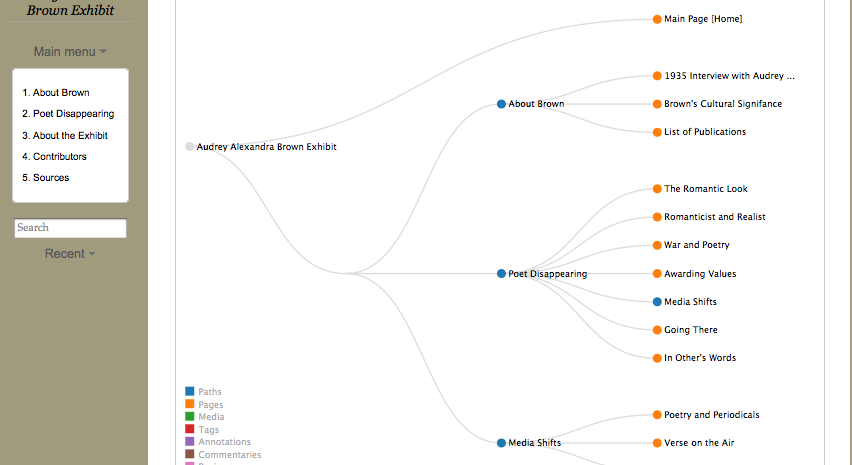How does a digital scholarly exhibit argue? Stan Ruecker and Alan Galey suggest that a good prototype makes a substantial argument. Extending their assessment of prototypes to a more general notion of digital projects, here is my report assessing whether the Audrey Alexandra Brown Exhibit fulfills Ruecker and Galey’s criteria:
R and G ask: Is the argument reified by the prototype contestable, defensible, and substantive?
On a technical level, showcasing images and audio housed in UVic Special Collections, and contextualizing these materials with a narrative, the Brown Exhibit argues that the purview of scholarly materials is in libraries. If scholars want to create credible work, then they need to include these kinds of resources, because resources in libraries will likely maintain appropriate metadata, including correct copyright information. In terms of narrative, the exhibit argues that materials should be grouped and showcased thematically. I’ve arranged images of Brown and her work into sections that speak to larger discussions in national literature, media studies, and women’s writing. Rather than arrange chronologically or by media type, methods that might be considered less subjective, I’ve foregrounded my own interpretation of the materials. The exhibit argues that the onus of interpretation falls on the arranger. It presumes that I have the authority and expertise necessary for scholarly interpretation.
R and G ask: Does the prototype have a recognizable position in the context of similar work, either in terms of concept or affordances?
Like the Deena Larsen collection among others, the Brown Exhibit considers archival remediation a necessary and valuable endeavor. Both projects enable online access to materials that may not otherwise be easily accessible. Both projects assume the importance of metadata and suggest that the information that contextualizes artifacts adds value to a visitor’s experience of that artifact.
R and G ask: Is the prototype part of a series of prototypes with an identifiable trajectory?
In the context of the Maker Lab, the Brown Exhibit is one of two Scalar books that are now being built to display remediated materials. Like the Crocodile Cafe Exhibit, the Brown Exhibit focuses on a very particular aspect of West Coast culture. Both value the local particularity of their subject matter and the ways culture is made through media. In a broader context, projects such as the Brown Women Writers Project and Orlando are also attempting to recover women writers in a digital environment. These projects all have the goal of bringing attention to the work of writers who have been historically overlooked or marginalized.
R and G ask: Does the prototype address possible objections?
I can see objections being raised about the need for material to be housed in the library. The time and effort argument as well as the metadata argument might be raised here. The first group would suggest that while it would be better for materials to come from the library, there are so many materials in need of remediation that it becomes difficult for librarians to keep pace with the growing demands of the scholarly community. The exhibit would argue that part of the value in digital work is in the affiliations that arise alongside the finished product. I hope that by including a narrative of process, by linking showcased objects to the library site, and by acknowledging librarians’ contributions, the exhibit will make this kind of claim. In terms of metadata standards, others might argue that standardized metadata, as required for library hosting, might not best represent all digital materials. The exhibit would argue, through the inclusion of narrative, that issues of classification not necessarily apparent in the library’s official metadata can be supplemented with additional narrative.
R and G ask: Is the prototype itself an original contribution to knowledge?
In foregrounding narrative as a way of organizing and showcasing remediated materials, the Brown Exhibit does make an original contribution to the field of scholarly exhibits. I see the exhibit functioning in parallel with the library. In one scenario, the materials can be accessed on the library’s CONTENTdm webpage; here visitors will have a simulated experience of archival serendipity. They can construct their own narratives, and make their own arguments about the work. However, with the Brown Exhibit, they also have the option of encountering the material as you might in a museum or art gallery, with additional interpretation based on another’s research interests. I think this second kind of encounter is more likely to start discussion; visitors can engage with the material in an unexpected context and they might have points on which they disagree. Galey and Ruecker point out, there is a way of interpreting artifacts such that they become ‘productively contestable.’ In other words, we are more likely to talk about materials when someone starts the discussion. So the exhibit argues that before digital remediation can have an impact, someone needs to do the work of interpretation.
Galey, Alan and Stan Ruecker. “How a Prototype Argues.” Literary and Linguistic Computing 25.4 (2010): 405-424. Oxford Journals. Web. 23 March 2013.
Post by Jana Millar Usiskin, attached to the AABrown project, with the exhibits tag. Featured images for this post care of the Audrey Alexandra Brown Exhibit (built using the Scalar platform) and Literary and Linguistic Computing, at llc.oxfordjournals.org.


